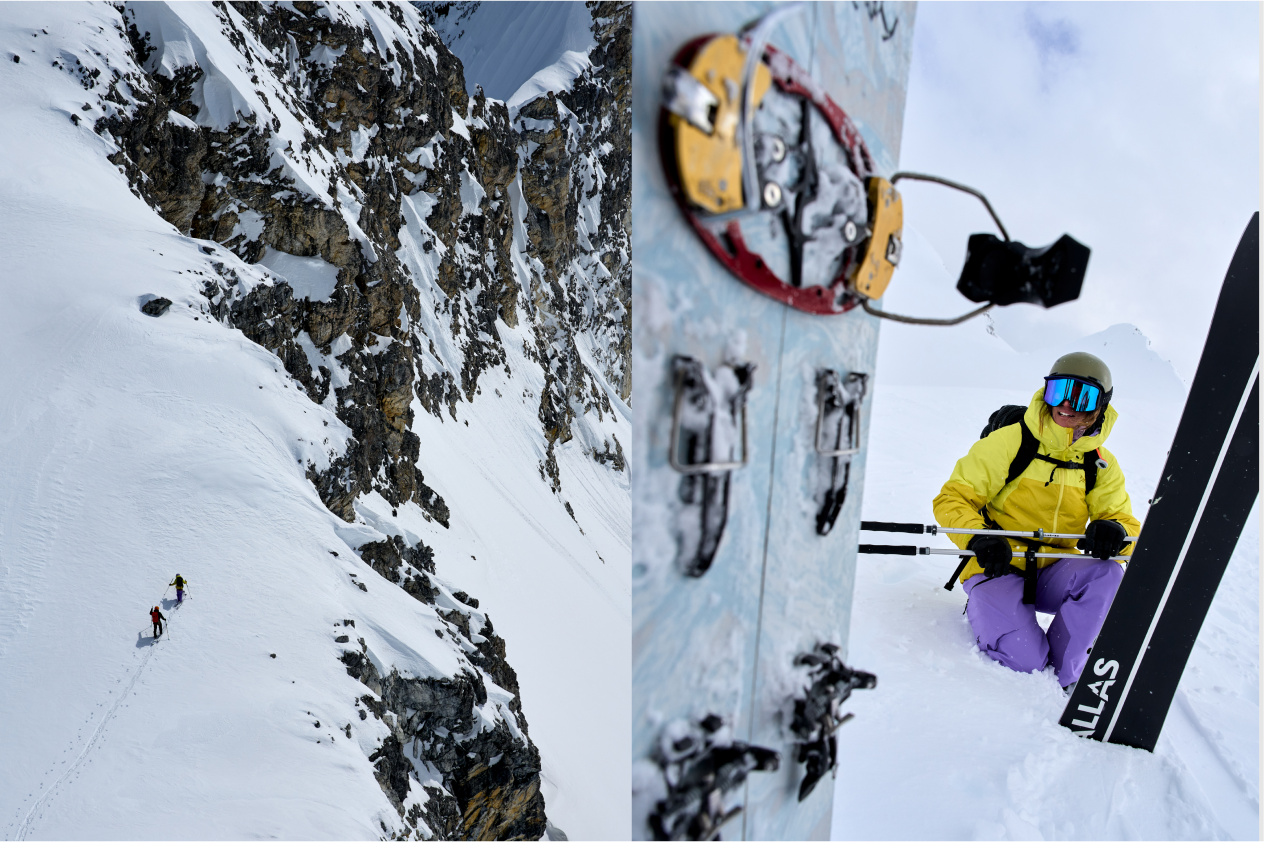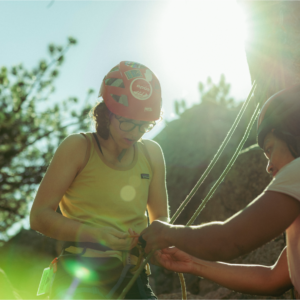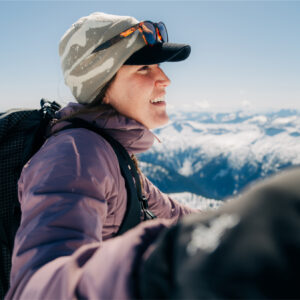
Stepping out
STEPPING OUT
Words by Ben Osborne | Photography by Ange Percival
Splitboard guiding in the mountains requires patience, precision, and—perhaps most importantly—curiosity. For ACMG guides Christine Feleki and Joey Vosburgh, the job is all–encompassing. But when they reflect on the lessons they’ve learned about the mountains and themselves, it’s undeniably worthwhile.
“There was some friction at the beginning when…
I mean, do you want me to get into the story?”
Joey Vosburgh’s baseline mood is giddiness. It shines through his eyes and is magnified by a gap in his grin where he’s missing a tooth. He lets out a chuckle when recounting the first time he met Christine Feleki, a little extra light bouncing off the rims of his wire-framed glasses.
That meeting was about a decade ago, at a backcountry lodge near Revelstoke, BC, when Joey and Christine’s paths were intersecting at different moments in their guiding journey. Joey was there for a mechanized ski course on his way to becoming an Apprentice Ski Guide, and Christine was there as a practicum student on her way into the Apprentice Ski Guide program. At the start of the course, they were both seated in the dining area of the timber-framed lodge.
“The lodge owner did this introductory speech to the staff and the ACMG [Association of Canadian Mountain Guides] candidates about what to expect over the week,” says Joey. “And at the end of his speech, he just goes, ‘If you want to be a snowboarder, you may as well just pack up and go home right now.’”
The comment was jarring but not without precedent. At the time, splitboarding was yet to be allowed by the ACMG as a method for earning a guiding certification, and snowboarding was still frowned upon and even outlawed at many resorts across the globe.
Joey and Christine would have to work twice as hard to prove they could move efficiently and safely through the mountains on a splitboard, but they had a trick up their sleeves: They came up as snowboarders in the ’90s and possessed the scrappy, rebellious, do-it-yourself attitude that, for anyone involved in the sport, felt like a survival tactic at the time. Facing resistance from the governing body of the ACMG, it was their persistence that allowed them to press onward, staying true to their preferred method of travel.

While guiding in the winter on a splitboard was a new concept at the time, ski guiding is far from a new profession in Canada—the ACMG was founded in 1963, and it became a member of the International Federation of Mountain Guides Associations in 1972.
Today, the ski and snowboard guiding industry thrives in small pockets across the globe. But variability exists between those pockets, with differing weather and avalanche forecasting techniques and philosophies on heuristics that are constantly evolving.
Even without that variance, all the factors that go into risk assessment can leave even seasoned backcountry skiers’ and riders’ heads spinning. Guides like Christine and Joey, who are now fully certified ACMG Ski Guides, are forging a new path forward, thriving in their careers by leaning on curiosity rather than their credentials or egos.

On an average day of guiding, by the time Joey is meeting a group of skiers and riders, he’s already been awake for at least three hours. First, there’s the rolling, stretching, and mobility work to nurture limbs that have continuously logged 150-plus days a year on snow. Some days, there’s a bike ride from his home in Revelstoke to the heli base — a commute he uses to calm himself down because, he says, “Not everybody’s quite ready for Joey to f*ckin’ get all crazy on them and tell them what I think.”
Then there’s the guides meeting, where the collective of lead and tail guides share observations from the night before; incoming weather information; and logistics regarding run selection, group sizes, and more.
Next, along with a cup of coffee, comes the part of the day that adds a layer of complexity: What will the group’s goals be? How well do they ski and ride? How will they mesh? Even on the “1-1-1” days, as Joey calls them (a “low” danger rating below tree line, at tree line, and in the alpine on the Avalanche Canada forecast), the dangers are ever-present, and there are always holes to be poked in even the most informed decisions.
While Joey has long called Selkirk Tangiers his employer, somewhere across the province is Christine Feleki, running the same program at one of the guiding operations she bounces between—early start, deep breaths, and a heavy dose of data.
At their core, they’re both confronting the same conundrum: How will they deal with high-stakes decision-making throughout the day, and how will they respond if things go wrong?
Even with mountains of data available to them, there are still questions to be answered every step of the way, after each run, and between laps. How will solar aspects react to the partly cloudy skies? Has the weak layer buried deep in the snowpack been compressed enough for them to let their guard down? How will 60-plus days prior in the mountains inform, and possibly influence, their decision-making?
These questions don’t have clear answers, and Christine’s success relies on her ability to come to terms with that while getting to know different mountain ranges, snowpacks, and clientele.

“It was challenging but also so cool to be working in a team where there was this long-term experience, so you could be pulling information from people who had this intimate relationship with that landscape and the environment,” says Christine, reflecting on her work with various guiding operations across British Columbia.
For Christine, humility and a willingness to admit what she doesn’t know is the best way to evolve.
“Uncertainty is a big part of ski guiding or being in the mountains in general,” she says. “I remember when I started taking the first courses, and there was this huge amount of uncertainty with everything. I thought, ‘How do you even go out here and make a decision?’ It all seemed so scary. Like, ‘What if this happens? What if that happens?’”
In one early course, Joey remembers being asked to look within when it came to the “What if?” questions.
“The first module was about human factors, and it was really a touchy-feely course where you go internal and you find out who you are. Like, ‘What’s your hazardous attitude? What’s your personality like? How does that personality jive with other personalities, and how does it direct how you make decisions out there?’”
Christine and Joey credit these conversations with helping them develop a level of humility and understand that they work best within a team framework.

“I don’t think either of us have the ‘Shut up and follow me’ attitude,” says Christine. “We want to share that decision-making with people—what we’re worried about in the snow, the weather, or the conditions—rather than just telling someone to follow. And I think both of us see the value in that type of guiding style.”
That wisdom and openness come from experience, and it represents a development in the guiding industry in Canada.
“If you can learn from someone else’s mistake versus having to go and make that mistake yourself, you’re going to live a little longer, hopefully,” says Christine. “I think that’s where the mindset shift has really changed.
“We are trying to make the best decisions and gain as much information as possible. Some of that information might come from your guest at the back of the group.”
Joey’s interest in including others comes from an ability to look at past situations and see where he might have needed to check himself. “When I track back any of the close calls that I’ve had, often I wanted to show, ‘This is how you do it,’” he says.
With a lifetime of experience in the mountains, forced introspection and trauma analysis have taught Joey and Christine that no matter how much you know, it’s impossible to catch every little detail, and acknowledging your blind spots is a constant work in progress.

“There are all sorts of heuristics involved around biases of familiarity, right? Which is something I’m constantly trying to balance,” says Joey. “Am I just becoming too familiar with this? Am I going to make a mistake because I’m too familiar and I just don’t see it anymore?”
Joey and Christine have had their fair share of close calls. But it’s their curiosity to know the mountains, themselves, and the people around them better that keeps them going. They believe this continued insistence on openness and curiosity keeps folks alive in the mountains and pushes the guiding industry into a new era.
“I think the part of guiding for any guide that I’ve ever encountered is there’s this curiosity to understand why things are happening. Which is why snow science continues to evolve, because no one’s sitting around pretending to know everything,” says Christine.

The job is dangerous, taxing, and ultimately in service of others. But for Christine, the collaboration between guides—that sense of shared curiosity—is what keeps her interested, continues to deepen her understanding of the mountains, and informs why she chose to become a guide in the first place.
“By bringing people into mountains, you create a connection with that environment,” reflects Christine.
“And then they’re more likely to have an interest in that environment and maybe more willing to protect it. When you can see that it’s special to somebody else, or they would never have been able to do it, there’s a bonus of just watching people accomplish something.”
“I can be quite the homebody, but then as soon as I am out in the mountains, there’s no place that I would rather be.”









